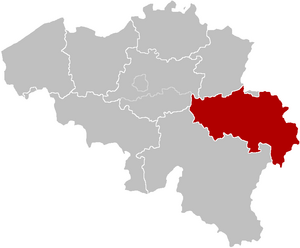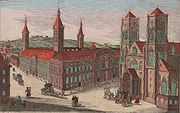Diocese of Liège
| Diocese of Liège | |
| Basic data | |
|---|---|
| Country | Belgium |
| Ecclesiastical province | Mechelen-Brussels |
| Metropolitan bishopric | Archdiocese of Mechelen-Brussels |
| Diocesan bishop | Jean-Pierre Delville |
| Emeritus diocesan bishop |
Albert Houssiau Aloys Jousten |
| Vicar General | Alphonse Borras |
| Episcopal Vicar | Jean Pohlen |
| surface | 3,862 km² |
| Parishes | 525 (2016 / AP 2017 ) |
| Residents | 1,092,226 (2016 / AP 2017 ) |
| Catholics | 731,000 (2016 / AP 2017 ) |
| proportion of | 66.9% |
| Diocesan priest | 301 (2016 / AP 2017 ) |
| Religious priest | 61 (2016 / AP 2017 ) |
| Catholics per priest | 2,019 |
| Permanent deacons | 71 (2016 / AP 2017 ) |
| Friars | 130 (2016 / AP 2017 ) |
| Religious sisters | 452 (2016 / AP 2017 ) |
| rite | Roman rite |
| Liturgical language | French , in the eastern cantons (partially): German |
| cathedral | Saint-Paul |
| Website | liege.diocese.be |
The diocese of Liège ( Latin : Dioecesis Leodiensis , French : Diocèse de Liège ) is one of 8 dioceses of the Roman Catholic Church in Belgium . It covers 3,862 km² and approx. 1,044,000 inhabitants (as of December 31, 2011). Since 1967 the borders of the Province of Liège have coincided with those of the diocese. The diocese includes 26 deaneries and 529 parishes. In 2014, around 68% of the population of Liège Province were Catholic. Around half of the population lives in the greater Liège area .
history
The diocese of Liège was founded by Maternus in the city of Tongeren in the 4th century on the site of today's Basilica of Our Lady and moved to Maastricht in the 6th century . It was not until 720 that Bishop Hubert took his seat in Liège. With the award of the county of Huy to Bishop Notger (972-1008), the basis for the rise of the bishops to imperial princes was laid. The diocese was a suffragan of Cologne until 1801 .
In the 14th century, the territory of the Principality of Liège was formed with secular sovereignty. As an imperial principality, the diocese was always caught between the dukes of Burgundy, the Kingdom of France and territories of the Roman-German Empire. The prince-bishopric ( Hochstift ) Liège belonged to the Lower Rhine-Westphalian Empire from 1500 .

In 1559, due to a reorganization of the dioceses in what was then the "Habsburg Netherlands" (includes today's Netherlands , Belgium without the prince-bishopric, Luxembourg and smaller parts of northern France) , the diocese of Liège was placed under the newly founded Archdiocese of Mechelen at the instigation of Philip II . At the same time, his diocesan area was reduced in size in favor of the newly founded diocese of Namur , but the bishopric was not transferred to the surrounding Burgundian Empire .
In 1794 the diocese was occupied by France and formally ceded to France in the Peace of Lunéville and added to the Ourthe department . However, by the decision of the Congress of Vienna and by a special treaty of March 23, 1815, it was left to the King of the Netherlands and since then has formed a province of the United Netherlands , but with changed borders, adding some parts of the former duchy to the provinces of Hainaut and Limburg and Namur , while others were defeated by Limburg, Luxemburg and Namur at Liège. During the revolution of 1830 , the residents of the city and province of Liège vigorously sided with the Belgians, and Liège has been a member since the Kingdom of Belgium was formed. The diocese borders were rewritten in 1840.
In 1925 the diocese of Eupen-Malmedy , which was only founded in 1920, was incorporated into the diocese of Liège. In 1967 the Hasselt diocese was re-established by outsourcing it from the Liège diocese.
The German-speaking areas of the German-speaking Community of Belgium belonging to the Diocese of Liège celebrate the services in the German liturgical language. Therefore, the Diocese of Liège is also co-editor of the German Catholic prayer and hymn book Praise God .
Partial view of the Prince-Bishop's Palace and the Lambertus Cathedral (Liège)
St. Paul's Cathedral (Liège) , cathedral of the diocese since 1801
See also
- List of the bishops of Tongeren, Maastricht and Liège
- Roman Catholic Church in Belgium
- List of Roman Catholic Dioceses
- List of former Catholic dioceses
Web links
- Homepage Diocese of Liège (French / German)
- Entry for the Diocese of Liège on catholic-hierarchy.org (English)
- Roman Catholic Diocese of Liège in Catholic Encyclopedia (English)
literature
- Gerhard Köbler : Historical lexicon of the German countries. The German territories from the Middle Ages to the present. 7th, completely revised edition. CH Beck, Munich 2007, ISBN 978-3-406-54986-1 , p. 399.
- Jean-Louis Kupper: Liege . In: Lexicon of the Middle Ages (LexMA). Volume 6, Artemis & Winkler, Munich / Zurich 1993, ISBN 3-7608-8906-9 , Sp. 25-27.


